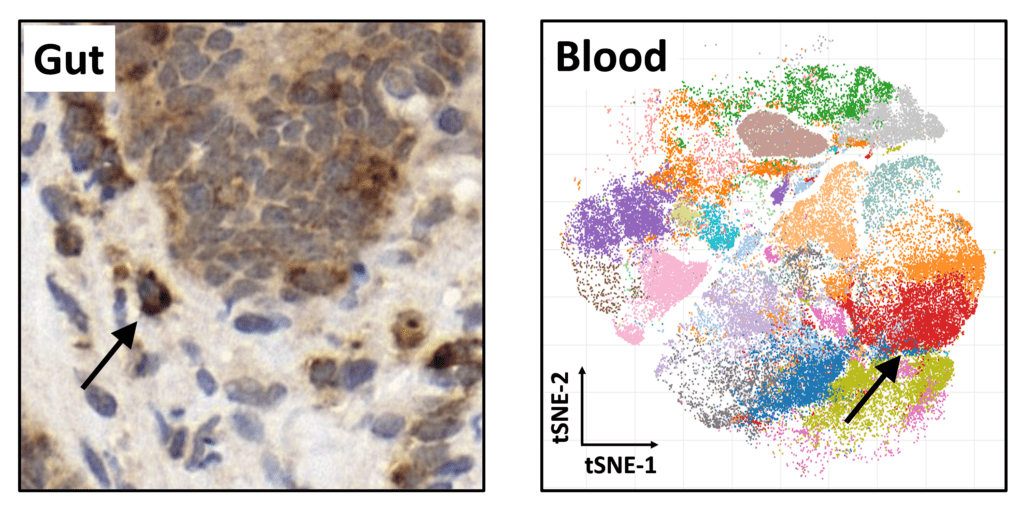Novel insights into graft-versus-host disease - a major barrier in stem cell transplantation
Research led by Barts Cancer Institute (BCI), Queen Mary University of London, has identified a subset of immune cells involved in site-specific tissue damage in cancer patients who have developed harmful graft-versus-host disease (GvHD) after stem cell transplantation. The insights gained from the study may help to define new targets for more selective approaches to prevent or treat this condition in patients who have received a stem cell transplant.
Allogeneic haematopoietic stem cell transplantation is the most widely used form of cellular immunotherapy for cancer. The treatment involves the infusion of stem cells from healthy donors into patients to replace damaged blood cells with healthy ones. Although it is the only curative treatment available for many patients with blood cancers, a major barrier to success of this treatment is when donor immune cells attack healthy patient tissues, which results in GvHD.
This study, published in Blood, has identified a set of immune cells that are uniquely involved in GvHD tissue damage in the gastro-intestinal (GI) tract - the site where GvHD is most difficult to control.
Immune cells selectively increased in GvHD tissue damage in the GI tract
By using tissue biopsies and blood samples from patients who had received allogeneic haematopoietic stem cell transplantation and comparing these to samples from healthy individuals, the team were able to examine the immune cells found in areas of GvHD tissue damage in the GI tract. Using a novel sequential tissue staining approach developed and applied by Dr Jenny Ball, a postdoctoral researcher in the Centre for Haemato-Oncology at BCI, the team identified and characterised a subset of donor immune cells called retinoic acid-responsive CD8 effector T cells that were selectively increased in areas of GvHD tissue damage in the GI tract. These cells were also detectable at increased frequencies in the blood of patients with GI GvHD but not found in other sites of tissue damage.

Further investigations in the laboratory allowed the team to identify the cytokine IL-23 as a major environmental factor within the GI tract that promotes the expansion of these pathogenic CD8 cells.
Dr Jeff Davies from BCI’s Centre for Haemato-Oncology, who led the study, said:
“Currently we cannot predict which patients will develop gastro-intestinal graft-versus-host disease, or prevent or treat it effectively without significant off-target toxicity. The population of cells (and the micro-environmental factors that license their expansion) identified in our study represent exciting new targets for more selective approaches to prevent or treat this condition in patients.”
The research was funded by Blood Cancer UK.
Considerations when translating research from bench to bedside
This study followed on from earlier research that investigated GI GvHD in preclinical models. These studies had implicated retinoic acid-responsive CD4 T cells (another subset of immune cell) in the pathogenesis of GI GvHD, but it was not previously known if these cells were also important in patients with GvHD. The current study by Dr Davies’ group confirms that this is indeed the case; however, it highlights a key difference between GI GvHD in patients and the findings of earlier preclinical studies - that the main subset of retinoic acid-responsive T cells that mediate human GI GvHD are CD8 T cells. Importantly, the study also extends upon the earlier findings by identifying the micro-environmental factors that licence expansion of these harmful cells.
Dr Davies said:
“Identifying such important differences between the immunobiology of preclinical models and what actually happens in patients is critical for successful translation of our findings into new clinical strategies.”
Potential to extend beyond cancer patients
The findings from this study help to further understand the tissue-specific pathways involved in GvHD in the GI tract, and may enable the development of new and improved ways to prevent or treat this condition.
Allogeneic haematopoietic stem cell transplantation is not only used as a treatment for blood cancers, but is also used to restore blood cell and immune function in conditions such as immunodeficiency, thalassaemia, sickle cell disease and bone marrow failure. Overcoming GvHD therefore has the potential to benefit many patients receiving allogeneic haematopoietic stem cell transplantation spanning a variety of health conditions.
The team now plan to develop more sophisticated models using human cells and tissue to better define the mechanisms involved in the generation of these pathogenic cells. They hope that these studies will identify ways to selectively target the cells that could be used in the clinic to improve haematopoietic stem cell transplantation as a treatment for patients with cancer and other disorders.
Category: General News, Publications

No comments yet